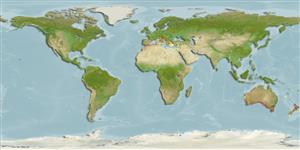Common names from other countries
Classification / Names / Names
Common names | Synonyms | Catalog of Fishes (gen., sp.) | ITIS | CoL | WoRMS
Environment: milieu / climate zone / depth range / distribution range
Ecology
Sessile; depth range 1 - 10 m (Ref. 87937). Subtropical
Atlantic, Mediterranean and Indo-Pacific.
Length at first maturity / Size / Weight / Age
Maturity: Lm ? range ? - ? cm Max length : 12.0 cm TL male/unsexed; (Ref. )
The main cylindrical axis is irregularly branched; 4 rows of branchlets alternayting with 4 rows of simple filamentous ramuli; the base of the thallus carries stolons more or less ramify; this species is characterized by having hooks that resembles a harpoon.
Occurs from upper infralittoral (Ref. 87937) to subtidal (Ref. 89053) areas.
Life cycle and mating behavior
Maturity | Reproduction | Spawning | Eggs | Fecundity | Larvae
Known to exhibit trigenetic life cycle (Ref. 87937).
Guiry, M.D. and G.M. Guiry. 2009. (Ref. 80701)
IUCN Red List Status (Ref. 130435)
CITES status (Ref. 108899)
Not Evaluated
Not Evaluated
Human uses
| FishSource |
Tools
More information
Age/SizeGrowthLength-weightLength-lengthMorphologyLarvaeAbundance
Internet sources
Estimates based on models
Preferred temperature
(Ref.
115969): 15.1 - 21.3, mean 18.3 (based on 774 cells).
